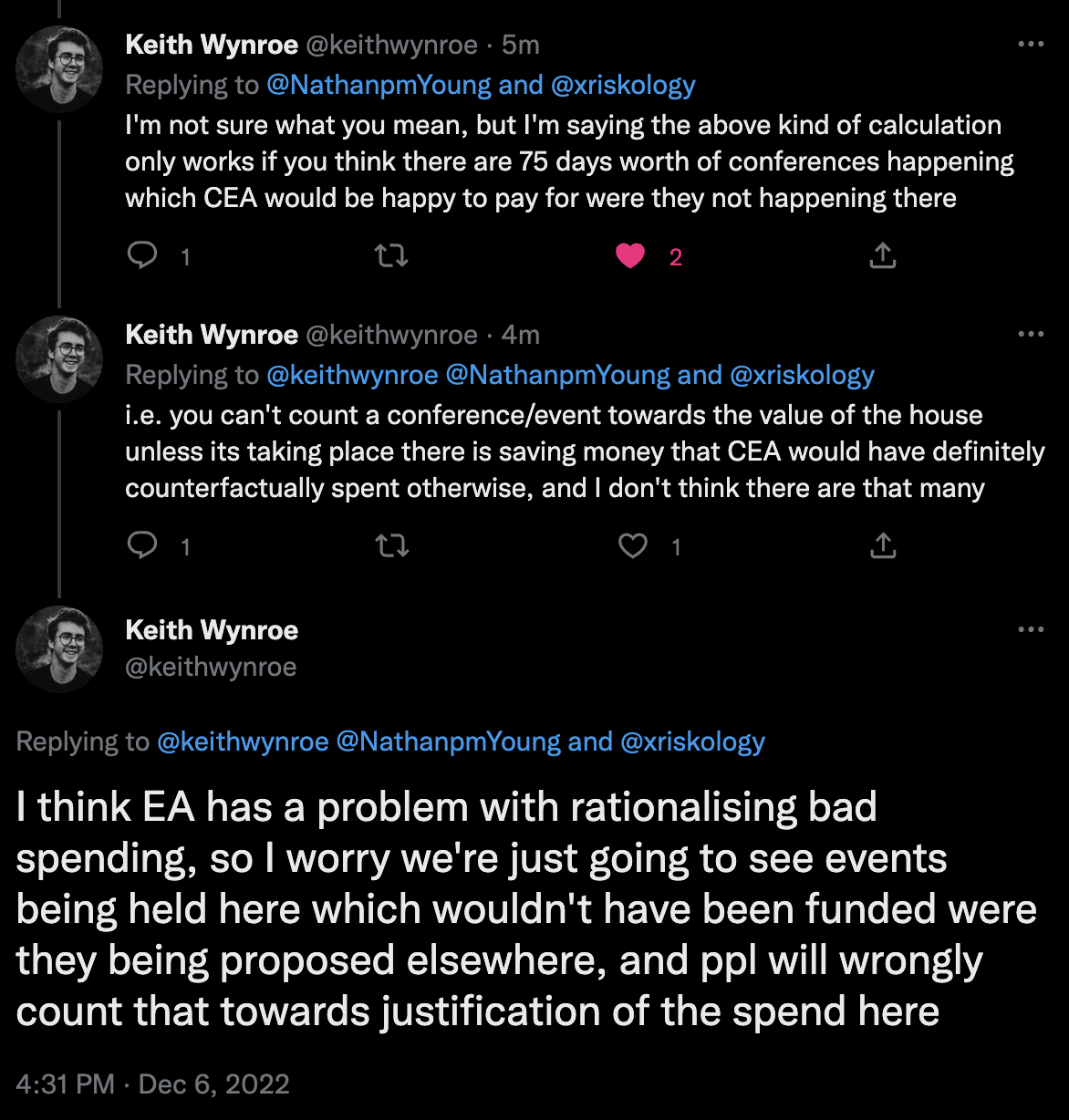Edit to add (9/1/2023): This post was written quickly and I judged things prematurely. I also regret not reaching out to Effective Ventures before posting it. Regarding my current opinion on the Abbey: I don't have anything really useful to say that isn't mentioned by others. The goal of this post was to ask a question and gather information, mostly because I was very surprised. I don't have a strong opinion on the purchase anymore and the ones I have are with high uncertainty. More thoughts in my case for transparent spending.
Yesterday morning I woke up and saw this tweet by Émile Torres: https://twitter.com/xriskology/status/1599511179738505216
I was shocked, angry and upset at first. Especially since it appears that the estate was for sale last year for 15 million pounds: https://twitter.com/RhiannonDauster/status/1599539148565934086
I'm not a big fan of Émile's writing and how they often misrepresent the EA movement. But that's not what this question is about, because they do raise a good point here: Why did CEA buy this property? My trust in CEA has been a bit shaky lately, and this doesn't help.
Apparently it was already mentioned in the New Yorker piece: https://www.newyorker.com/magazine/2022/08/15/the-reluctant-prophet-of-effective-altruism#:~:text=Last year%2C the Centre for Effective Altruism bought Wytham Abbey%2C a palatial estate near Oxford%2C built in 1480. Money%2C which no longer seemed an object%2C was increasingly being reinvested in the community itself.
"Last year, the Centre for Effective Altruism bought Wytham Abbey, a palatial estate near Oxford, built in 1480. Money, which no longer seemed an object, was increasingly being reinvested in the community itself."
For some reason I glanced over it at the time, or I just didn't realize the seriousness of it.
Upon more research, I came across this comment by Shakeel Hashim: "In April, Effective Ventures purchased Wytham Abbey and some land around it (but <1% of the 2,500 acre estate you're suggesting). Wytham is in the process of being established as a convening centre to run workshops and meetings that bring together people to think seriously about how to address important problems in the world. The vision is modelled on traditional specialist conference centres, e.g. Oberwolfach, The Rockefeller Foundation Bellagio Center or the Brocher Foundation.
The purchase was made from a large grant made specifically for this. There was no money from FTX or affiliated individuals or organizations." https://forum.effectivealtruism.org/posts/Et7oPMu6czhEd8ExW/why-you-re-not-hearing-as-much-from-ea-orgs-as-you-d-like?commentId=uRDZKw24mYe2NP4eq
I'm very relieved to hear money from individual donors wasn't used. And the <1% suggests 15 million pounds perhaps wasn't spent. Still, I'd love to hear and understand more about this project and why CEA thinks it's cost-effective. What is the EV calculation behind it?
Like the New Yorker piece points out, with more funding there has been a lot of spending within the movement itself. And that's fine, great even. This way more outreach can be done and the movement can grow. But we don't want to be too self-serving, and I'm scared too much of this thinking will lead to rationalizing lavish expenses (and I'm afraid this is already happening). There needs to be more transparency behind big expenses.
Edit to add: If this expense has been made a while back, why not announce it then?


In my experience from actually renting spaces to run tech conferences and events, a convention hall in a reasonably dense city runs in the tens of thousands for a single <5 day long event.
Consider just 3 breakout rooms, typically ~$90-$180/room/hour, 8 hours a day, 5 days takes you into the $20-$40k range, that gets you no food, no lodging for attendees, once you add that stuff in and the all-in cost for a fully-paid for typical 30-40 person event can easily land just inside $80-100k, with costs growing slightly sublinearly per person for a while before they balloon again once you rise above the size where there are multiple competing venues in your area.
If the convention center you are using isn't a hotel now you have to move your attendees back and forth. For tech conferences you can charge a few hundred $ per person, and have them book with your hotel out of a bloc, incurring obligations from your org to a hotel about occupancy, and then you can generally come up with a way to make your event break even. Conferences are expensive for a reason.
Locating an event in the middle of nowhere? Maybe that room becomes maybe a fixed rate $350 space at a cheaper hotel, $1000/day for 3 becomes so $5k for a 5 day event, but now its harder to get folks to the venue.
At the end of the day, in either of these scenarios you are subsidizing the hotel and event space industry rather than focusing in on your events.
On the other hand, using the model of a typical CFAR event, using a venue that is already owned, you are dealing with some cleanup, a couple of members of the team providing operations support, catering costs, but the venue itself remains relatively customized to purpose. People can sleep on site, enabling folks to drift in and out of conversations, the event can run all night with people talking in smaller more intimate groups long past when a hotel would have kicked you out of the space. If your goal is to built a community and have folks come together, this is a much better model.
If you can keep this above 50% utilization, this even strikes me as way more than break-even or even if I'm delusionally out of touch and hotel prices have some how plummeted in the last 3 years while the cost of everything else has gone up, at least far closer than the 10-100x swing you are arguing for here.
Lightcone, by comparison, has been getting about 75% utilization out of the home it has been using as a conference space.